Do-it-yourself pool waterproofing: review of technologies + step-by-step example of work
The construction of a concrete bowl, despite the emergence of new designs, is the most common option for constructing stationary pools.However, this material tends to absorb moisture, which subsequently destroys the structure.
Agree, I wouldn’t want to spend a lot of money on building an artificial reservoir only to find cracks in a couple of years. Timely waterproofing of the pool will help prevent the appearance of defects in the concrete bowl.
We will tell you about the most effective methods of moisture protection, and also describe step by step the technology for constructing a water barrier.
The content of the article:
Why waterproof your pool?
Concrete is a strong and durable material, but it is characterized by increased porosity. Water that has seeped into the thickness of the material is easily absorbed and retained for a long time, becoming a favorable environment for the development of mold.
When exposed to sub-zero temperatures, such a wall becomes a conductor of cold, and freezing of the liquid leads to the appearance of cracks and mechanical destruction of the structure.

The installation of reliable waterproofing of the inner surface of the pool bowl is beyond doubt, since it is filled with water. However, destruction can also occur from the outside.
Concrete is characterized by the so-called “capillary suction” of liquid, when moisture is drawn in from the environment - soil, air with high humidity, and precipitation. In this regard, the outer side of the pool bowl is also necessarily subject to waterproofing measures.

Often the walls of the pool are built from separate blocks. In this case, the connecting seams pose a danger. The strength of the connecting mortar is significantly lower than the strength of concrete slabs. Therefore, if water begins to seep in such a place, then under the influence of the pressure of the mass of the liquid, the material quickly collapses.
There is first a drip of seepage, then a small drip that washes away the solution particles and turns into a decent leak.
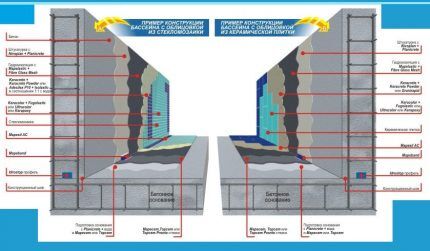
Methods for moisture protection of concrete structures
Waterproofing can be surface, internal or combined.
To ensure moisture protection of structures made of monolithic concrete or concrete blocks, the following means are used:
- Deep penetration compositions – clog even microscopic cracks, working at the level of capillaries.
- Additives for sand-cement mixture – increase the hydrophobicity of concrete.
- Liquid glass - a composition that, after hardening, forms a solid moisture-proof layer on the surface.
- Liquid and viscous compositions – so-called liquid rubber and coating waterproofing, forming a strong elastic membrane.
- Rolled film coatings, glued to the concrete surface.
Each product has its own characteristics, which determine the scope of application and method of application.
Penetrating waterproofing compounds
Penetrating materials are cement-sand mixtures with active chemical additives. Dilute with water and apply to a well-moistened surface.
Active substances in the presence of water begin to react with particles of the concrete mixture - free lime. As a result, insoluble crystals of calcium hydrosilicates and hydroaluminates are formed.
In this way, the concrete is compacted deeply - the active components of the waterproofing, due to capillary suction, penetrate even the smallest cracks. A moisture barrier is formed.
When all the water molecules have reacted, the crystal formation process stops. Renewing contact with the liquid restarts it, causing even greater compaction and waterproofing.
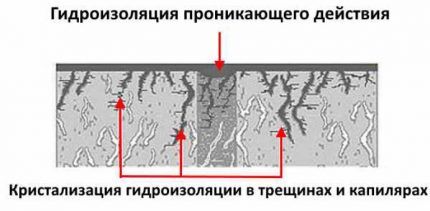
The thickness of the formed layer can reach 10-20 cm. The protection is not afraid of mechanical damage, increases the frost resistance of concrete and the durability of the entire structure.
However, penetrating waterproofing does not provide 100% protection against moisture during constant contact with liquid. Therefore, it is used as a pre-treatment before applying the main protective layer.
Hydrophobic additives for concrete
The principle of operation of waterproofing additives is the same as that of penetrating compounds. Only in this case, not only the layer at the surface is protected - the entire mass of material becomes hydrophobic.
The calcium hydroxide, or free lime, in ordinary concrete leaches over time, leaving a large number of microscopic capillaries and cavities.
Active additives added to the mixture already at the concrete hardening stage interact with calcium hydroxide and water molecules. Growing in the solution, they fill the resulting microcavities and pores.
A cast concrete structure or individual blocks acquire the properties of a stone monolith. With further exposure to water, the surface of the structure becomes even more compacted.
A structure made from such concrete not only has moisture resistance - it is characterized by increased strength, frost and heat resistance, and resistance to the aggressive effects of environmental chemical compounds.
Additives not only help fill micropores - larger cavities are lined with a layer of insoluble crystals. Due to this, the wettability of the surface is minimized and the effect of capillary retraction is eliminated.
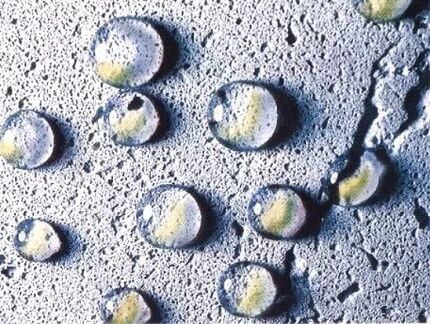
However, in addition to the positive properties, this characteristic also has a disadvantage. The formation of a waterproof layer leads to low adhesion with adhesives and plaster. Therefore, before applying finishing coatings, it is necessary to take measures to increase the surface roughness of the material.
Liquid glass is an effective remedy
Liquid glass is a solution of potassium or sodium silicates. The composition is a transparent liquid mass, which, when hardened, forms a solid glass-like layer. The principle of operation of such waterproofing is based on the ability of the solution to spontaneously harden.
Thanks to its fluid texture, liquid glass fills the pores and cracks of the protected surface. Due to this, possible paths for the passage of liquid are completely blocked.The composition makes the treated concrete surface waterproof and increases its strength.

The composition is characterized by good adhesion and is easy to apply - by roller, brush or spray. The treatment is carried out in two or three layers, waiting for the applied solution to completely harden.
It should be borne in mind that liquid glass sets very quickly. Therefore, some skill is required to carry out the work. This creates difficulties when waterproofing the tank yourself.
The frozen layer has properties close to glass - it is hard and quite fragile. For treating surfaces that are constantly in contact with water, it is used only as a basis for gluing with polymer films.
Liquid and viscous waterproofing
Easy to apply and effective liquid products are becoming increasingly common. These are compositions based on bitumen, latex, silicone, and polymers. They are applied to the surface with a regular brush, spray or roller.
The compositions are characterized by good adhesion to the surface - they fill micro-irregularities, pores and cracks, forming a dense, moisture-proof membrane.

Liquid insulators are divided into two types:
- Aqueous emulsions. They have almost no smell, hardening occurs only due to polymerization processes.
- Compositions based on organic solvents. When applied and hardened, they release toxic substances and are therefore not recommended for indoor use. After application, the solvent evaporates, leaving an elastic hydrophobic base on the surface.
Products most often do not require pre-treatment of the surface. Apply in several layers. The result is a strong and elastic membrane that has no joints or seams.
Such a waterproof barrier is not afraid of any water hammer of water supply system, neither fluid pressure, nor shrinkage of the concrete structure and the appearance of small cracks in it. The film will remain intact.

There are the following compositions of liquid and coating waterproofing:
- Bituminous. This is a traditional waterproofing - a viscous organic compound of deep black color. It is applied hot, which makes the technology a fire hazard. In addition, the coating does not withstand low temperatures and lasts only 6-7 years.
- Bitumen-polymer. The composition does not require heating before application. The addition of polymers makes the composition more elastic and frost-resistant. Increases adhesion to the treated surface. Used outdoors or in ventilated areas.
- Bitumen-latex, or liquid rubber. Latex is harmless and odorless, so the product can be used for interior work.
- Water-based acrylic solutions. Contains mineral fillers and pigments. They can be white or colored. These are used for the finishing layer, which does not require additional painting or lining.
Colored polymer mastics are often used independently, without any finishing coating.In this case, to increase the wear resistance and strength of the coating, a reinforcing fiberglass mesh is embedded in the first layer of the applied mass. Wait for complete polymerization and cover with a second layer.
Such a protective barrier can withstand even severe mechanical stress.
The disadvantage of almost all such compositions is that ultraviolet radiation has a negative effect on the finished coating, including loss of elasticity and cracking. Therefore, outdoor pools are additionally coated with a protective agent.
Coating with polymer films
Covering the concrete surface with PVC film is the most economical method of waterproofing a swimming pool. The film is a ready-made membrane with a thickness of 1-1.5 mm, supplied in rolls. It is lightweight, resistant to aggressive chemicals, and completely waterproof.
Membranes can be smooth - for easy cleaning, or with a rough surface - for covering stairs and the bottom of children's pools. Those reinforced with fiberglass mesh are more durable and last longer. Non-reinforced ones are cheaper, but their service life is only 5-6 years. After this, the polymer film must be replaced.
Waterproofing concrete with polymer membranes requires a professional approach, and doing it yourself is quite difficult. Preliminary surface treatment with penetrating waterproofing or liquid glass is required.
The film should be laid on a layer of geotextile to avoid condensation and prevent friction of the membrane on a rough surface.
In this case, good adhesion of the film to the surface should be ensured to prevent peeling. Welding of seams is carried out using special equipment. The connection must be tight - the slightest inaccuracy will lead to liquid penetration under the waterproofing layer.

Internal and external waterproofing of the pool
Measures for moisture protection of structural elements of the tank should be carried out on both sides at the stage pool construction. There are internal and external waterproofing of the pool. External waterproofing is installed to protect the structure from the penetration of groundwater.
Internal - protects the structure from the effects of liquid, which with its mass presses on the surface of the bowl.
The choice of waterproofing methods depends on the location of the pool - outdoors or indoors, air humidity, the height of the aquifer, and the type of soil.
Protecting the reservoir from groundwater
The pool should be protected from groundwater penetration at the construction stage - before the bowl is erected. A sand cushion is placed under the structure, on which an overlapping sheet of roofing material or other dense waterproof material is laid.
If groundwater is close, it will also be necessary to install a waterproofing screen made of clay or loam with a thickness of at least 30 cm.
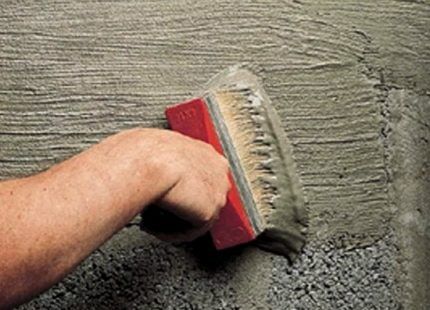
To strengthen concrete and increase its hydrophobic properties, special additives or liquid glass are added to the sand-cement mixture. However, this requires strict adherence to the recipe and proportions.
This is quite difficult to do when building a pool yourself. At home, it is easier to treat the finished structure from the outside with liquid glass or penetrating waterproofing.
When installing a swimming pool in a house, penetrating waterproofing will protect against water seepage from the pool bowl. In this case, the concrete will begin to harden inward - towards the movement of the liquid, preventing it from passing out and preventing flooding of the space surrounding the pool.
On immovable soils (rocky, semi-rocky rocks, low-moisture sands with a low-lying aquifer), treatment with a penetrating composition is sufficient.
But clay soils are susceptible to frost heaving and seasonal changes. In such areas, microcracks may appear, into which moisture will begin to be drawn. Surface coating, especially liquid glass, will not help in this case.
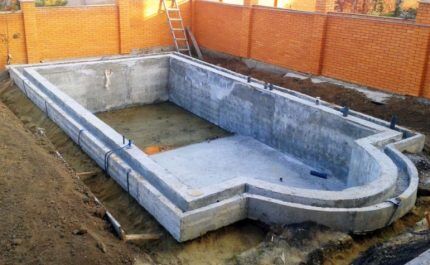
Therefore, before constructing a concrete bowl, soils that are unstable during frosts are removed from the pit. Peat removal and loess loam and sandy loam removal are mandatory.
Reliable moisture protection is ensured by applying coating waterproofing or liquid rubber. The durable film formed after polymerization withstands aggressive influences and soil pressure and is not damaged by shrinkage of the concrete structure
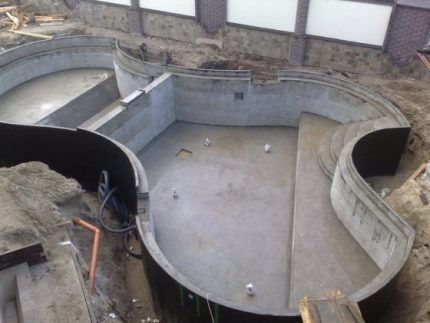
Waterproofing the inner surface of the bowl
Work to protect the inner surface from exposure to water must be carried out especially carefully. Errors in the waterproofing device lead to leaks and/or dampening of the concrete, which may not even be noticed. As a result, the material is destroyed and mold appears. Repair work ends up being very expensive.
Therefore, it is better not to skimp on internal waterproofing. To increase efficiency, several different methods are used at once.
The protective coating of the bowl must meet the following requirements:
- absolute moisture resistance;
- elasticity at the same time as strength;
- ability to withstand hydrostatic and dynamic loads;
- good adhesion to the surface;
- resistance to biological destruction by microorganisms, aggressive effects of water and antimicrobial additives contained in it (chlorine-containing preparations);
The material for internal waterproofing of the pool bowl must be environmentally friendly and resistant to ultraviolet radiation and temperature changes.
The following meet these requirements types of waterproofing:
- liquid rubber and water-based polymer compounds;
- deep penetration materials;
- protection by polymer membranes.
You can use a combination of three products at once, or limit yourself to two.
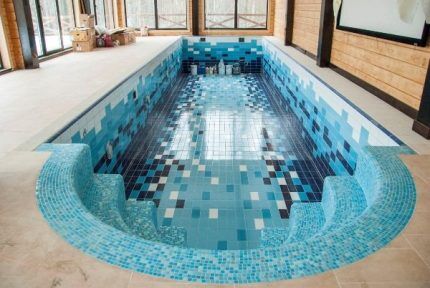
Covering the surface of the tank bowl with ceramic tiles or mosaics also remains relevant. This coating is durable - it is resistant to any impact, washes well and can easily withstand water pressure.
Individual elements are completely waterproof. The seams are dangerous. Even the use of waterproof grout does not guarantee against liquid penetration.
Therefore, before cladding, the surface must be treated with moisture-protective agents. The combination of a penetrating composition with a coating mastic is the most effective waterproofing of the pool bowl applied under the tiles.
For pools located indoors, proper humidity will play an important role in maintaining normal humidity. organization of ventilation.
How to make waterproofing yourself
The simplest and most effective method for self-waterproofing a pool is to apply penetrating and then viscous coating compounds. However, for the coating to be reliable, it is necessary to follow the technology.
The ambient temperature during work should not be lower than +5°C. In hot sunny weather, areas where mastic is applied are shaded or worked in the morning and evening.
The mastic must be mixed thoroughly before use. To do this, use a ribbon mixer to eliminate air entrainment into the coating mixture.
Stages of waterproofing work:
- The concrete base is cleaned. Chips, cavities and cracks are expanded and covered. The surfaces of the walls and bottom are leveled.
- A layer of penetrating insulation is applied to a well-moistened base. Seams, cracks, and service entry points are treated especially carefully. Waiting to dry.
- Surfaces are degreased with a weak acid solution, which is left for an hour. Then it is washed off with water and the residues are neutralized with a 4-5% solution of soda ash.
- Completely dry the surface to be treated.
- Apply the first layer of mastic 2-3 mm thick. Vertical surfaces are treated with a roller or brush. Horizontal - pouring method followed by distribution with a needle roller, which will help remove air bubbles from the mass.
- Reinforced fiberglass mesh is embedded in the slightly set layer of waterproofing and wait for complete polymerization (hardening) of the composition.
- A second layer of mastic is applied, the thickness of which can be from 1 to 3 mm.
The waterproofing layer must dry for at least 3 days, on surfaces in contact with water - 14-15 days. During this time, do not step on or walk on treated surfaces.
To prevent uneven drying and form a strong and elastic membrane, the applied coating is periodically moistened with water during the polymerization process and covered with a film.
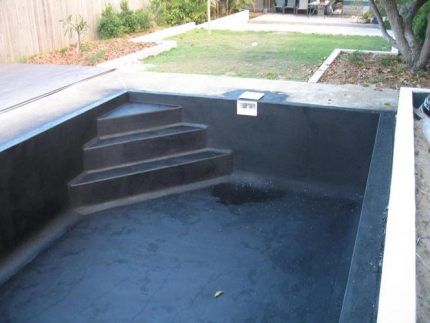
Using this technology, it is possible to carry out both internal and external waterproofing of the pool.The surface prepared in this way is ready for finishing. You can tile the pool, cover it with PVC film, or cover it with colored liquid rubber.
Conclusions and useful video on the topic
How to properly apply penetrating waterproofing. An example of surface preparation and treatment of a pool with Vandex materials:
Waterproofing a swimming pool with a polymer membrane:
Moisture protection of the bowl using liquid rubber. Spraying allows you to obtain a uniform layer of the same thickness:
Regardless of the method used to waterproof the pool, you should check the reliability of the coating for the absence of leaks. To do this, fill the container with water and keep it for about 10-15 days.
During this time, the area around the pool is periodically checked for leaks. And only if there are no errors in waterproofing, they begin finishing.
Do you have experience waterproofing a concrete pool? Please share information with our readers, tell us about your method of solving the issue. You can leave comments in the form below.




Last year I built a small pool on my property. Waterproofing was done with liquid glass. This is the best option if you balance reliability with ease of use. I completed the application myself in a day - I used a roller to cover the entire surface of the bowl. The composition is good, it does not spread and is not too thick, it lays down evenly, fills all the cracks, and sets quickly.
There was a problem with the pool. Partial detachment of the mosaic occurred, reaching the depth of the reinforcing mesh. As far as I can understand, this is the top layer of waterproofing. There is a leak, or there is no leak. I assume that this is due to the fact that the foundation is “walking”.In such a situation, is it possible to make some kind of patch on critical areas or will the entire pool have to be redone?